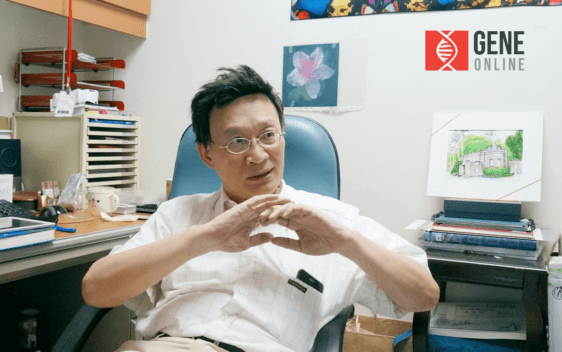The Orientation of Genomics in the Development of Prenatal Diagnosis in Taiwan by Dr. Fon-Jou Hsieh
Prologue
After 12 years of promoting genetic testing for polycystic kidney disease (PKD), the National Polycystic Kidney Disease Patient Association was finally established on May 17th, 2015 at the National Taiwan University Hospital.
With a multidisciplinary medical team, genetic testing, and the patient association, PKD patients finally have the availability to completed medical care, genetic and fertility counseling, daily life and nutrition guidance, and social supports.
God helps those who help themselves.
For three generations, senior patient Mr. Garfield and his family, a total of 22 members, 12 were ill with PKD, both men and women. This evidence demonstrates that such disease is autosomal dominant inherited, and highlights the absolute necessity of genetic diagnosis. Mr. Garfield also shared his experiences on applying for catastrophic illness and dealing with military service issues, which significantly benefited many other PKD patients. Taiwan was once called the Kingdom of Dialysis, yet the number of hereditary PKD patients among all kidney failures was never a concern as they all had to go through dialysis anyway. Now, with reliable and feasible genetic testing available, numbers of dialysis patients due to PKD shall be reduced.
Human genome sequencing was completed in 2003; hence unlocking the secret code of human life became another major milestone in human history ever since moon landing. Thereafter, genomics has become the “prominent study” of the 21st century. One nation after another invests enormous resource in; scholars study solitary in gene function, gene therapy, stem cells, immunotherapy, etc.; related studies and publishes just spring up like mushrooms. With 40 years medical experience crossing from prenatal diagnosis to genomics, Dr. Fon-Jou Hsieh (謝豐舟) managed to discover the true essence of present genomics from years of clinical experiences as well as from the thread of genetic history. He would like to remind people not to forget the original intention of genetics while hoping genetic testing would remain on the proper path to benefit more people in need.
The Reason of crossing into Genomics from Obstetrics and Gynecology
“The departments which need genetic clinical practice the most are obstetrics and gynecology, as well as pediatrics,” Dr. Heish says it firmly. The purpose of medical genetics is to assist disease diagnosis and treatment from the perspective of chromosomes and genes. Dr. Heish had no notion of genetics during his medical student years, not until he started to practice obstetrics and gynecology that he encountered all sorts of birth defects. He had seem families crashing down after having Down syndrome or severe cleft lip newborns, and had to face fetal edema caused by Mediterranean anemia, with mother also having complications…. Dr. Hsieh used to wonder whether those defects could be detected before birth, and he determined to be able to provide prenatal diagnosis on birth defects to relieve families from the uncertain fear of having genetic diseases.

As a result, his long journey of medical genetics began from here. He started with exploring fetal ultrasound examinations, later developed and popularized prenatal diagnosis techniques such as amniocentesis, chorionic villus sampling, fetal blood sampling, and Down syndrome maternal blood screening. He also expedited the Genetic Counseling Program at the National Taiwan University in 2003 to cultivate genetic counselors. His field of study includes chromosomal diseases, single gene diseases, and cancer genome microarray. After 40 years, he has finally witnessed the upsurge of genomics, and the dream to make a birth defect no longer a shocker has also came true.
The knowledge and technology we have now on medical genetics is still focusing on diagnosis, but there is therapeutic potential as well. For example, more than 20 years ago, Dr. Hsieh has once performed an intrauterine cord injection 5 times and successfully saved a familial edema fetus (due to an extremely rare atrioventricular nodal tachycardia) which has now grown into a healthy, lively college student. While in the past, genetic disease appeared to be limited to rare diseases, we now know that most diseases have a genetic component as genome research progresses. During a flu epidemic, some have fever, coughing, running nose, or even pneumonia, while some others have nothing. We used to think the difference was caused by the resistance level of each person, but in fact it was also caused by genes. Some people even think that cancer is an acquired genetic disease. A great part of the efforts of the present genomic medicine is hoping to analysis the genetic factors of various diseases, especially chronic diseases like cancer, hypertension, diabetes, etc., then find out diagnosis and treatment targets.
Medical Trilogy of Single Gene Disease
Among all diseases, “single gene disease” shows the most obvious genetic component as the disease is caused by a single gene malfunction. Common single gene disease in Taiwan includes Mediterranean anemia, hemophilia, muscular dystrophy, and achondroplasia, etc. Many rare diseases we often seen on newspapers such as osteogenesis imperfecta and amyotrophic lateral sclerosis are also single gene diseases. A human contains 23,000 genes, hence there should be 23,000 kinds of single gene disease, yet only 7,000 have been discovered so far. These single gene diseases account for about 5% of all diseases, although the total number seems fairly small, each disease has its very own condition, which makes diagnosis and treatment very difficult. On top of that, the number of patients of each disease is small, which often makes them the nomads, wandering among different departments in hospitals.
Dr. Hsieh later came up with a solution by proposing a“medical trilogy” to allow physicians of different departments to discuss treatment strategies of rare diseases together, as well as spare the time and energy of patients wandering in the hospitals. First is to offer a “joint clinic” by gathering 7 or 8 physicians from different departments to examine patients at the same time in the morning of first week of each month. Second is to assemble a “patients association” to gather patients with the same disease to encourage and support each other, while arise their demands to the society through the strength of masses. Third is to have “genetic testing” to identify the disease type of each patient in order to provide the treatments accordingly. This trilogy strategy has already been applied to tuberous sclerosis complex (TSC), Down’s syndrome, PKD, and Muscular dystrophy in the National Taiwan University Hospital. On May 15th, 2016, also known as the Tuberous Sclerosis Complex Global Awareness Day, 14 buildings, including 101, in the Xinyi District in Taipei lighted up in blue at 6pm simultaneously with high-rises all over the major cities in the world. It showed that Taiwan Tuberous Sclerosis Complex Association has integrated into the global community.
Precision Medicine Era: Longing for inclusion of single gene disease
Current biomedical resources in Taiwan are mainly focused on precision medicine on major diseases such as cancer and hepatitis. Dr. Hsieh has once discussed with the leading executives of genome research, hoping to arise the attention on single gene diseases. However, they indicated that diagnosis and treatment for single gene diseases relied on clinical practices not on research. Plus, the mutation genes for TSC and breast cancer have already been found, hence, single gene diseases were excluded from the National Genome research projects.
Dr. Hsieh says: “We used to think we could solve the problem with a single gene of the disease found. The truth is, though the gene of TSC has been found, it remains unknown how the mutation has caused all the different symptoms. So far, we only know that the TSC gene can control the cell size in a fruit fly, but we have no idea why the gene mutation can cause teratoma on human. Thus, we still have a long way to go on gene functions.” He expresses that patients with single gene disease are invaluable assets from God for us to understand the functions of human genes, as they can provide all sorts of information and clues that are not available from animal models since human beings are after all not the same as model organisms.
Dr. Hsieh further mentions that we should consider the genotype and the phenotype while study on human diseases, with a single gene disease, the genotype and the phenotype has a 1-to-1 causal relationship, while it is not the case on many other diseases, as there are environmental and probability factors mixed in the middle. Therefore, for most diseases, even the key gene has been found, the relationship of its genotype and its phenotype may not necessary be linear. Thus, with the same amount of time and resource involved, the effectiveness on a single gene disease will be more obvious compare to other diseases. Take the kidney disease as an example, among the large number of dialysis patients in Taiwan, 5 to 10% were caused by genetic inheritance (i.e. PKD). 5% of 70,000 dialysis patients equals to 3,500 people, if they do not take the genetic testing, their children have a 50% chance end up with dialysis; if they all take the testing, then have the hospital doing prenatal screenings to select good fertilized eggs, then the number of dialysis patients for sure will decline in the future. Therefore, single gene disease is not only a clinical issue, but it also affects the future of many families. Lately, world renowned pharmaceutical companies, such as Novartis, all started to invest in developing single gene disease drugs as well.

Introspection on the Development of Genomics in Taiwan: Do not forget the original intention
Genomics has become the mainstream of biomedical research, which can be divided into two levels: genome science and genome medicine. The former studies the basic principles of genome structures and functions, while the latter focuses on the medical application of genome related knowledge and technology, such as DNA diagnosis, gene therapy, or cell therapy. People have overlooked a fact during the genome fever: genomic science and genomic medicine are flourish at advanced countries is because they have over hundred years of long progress in genetics, developmental biology, and evolutionary biology to lay a solid foundation for today’s genomics development.
Throughout the development of genomics, from the late 19th century to the early 20th century, Darwin’s evolution theory, Mendel found the basic laws of heredity, Weissman, Roux, Driesch, de Vries and others revealed the secret of how organisms evolved from a single cell. Later, Thomas Morgan developed the chromosome theory which achieved mastery of genetic, development, and evolution, and therefore won the Nobel Prize in 1933. The genetic theory of which has drove the biology development of the 20th century. Hence, to explore the true colors of genes, the popular functional genomics, it has to begin from genetics, development, and evolution in order to master the essence.
The medical education system in Taiwan should lay a solid knowledge base from making medical genetics the foundation of genome medicine, related research units shall carefully collect phenotype and genetic material of various diseases, and manage and preserve effectively in the long run in order to help the development of biomedical research. In addition, for the hospital system, besides obstetrics and gynecology and pediatrics, each clinical department should strengthen trainings in teaching, service and research in order to meet the challenges of the genome era. In fact, there are many excellent researchers in the field of biomedicine in Taiwan. But if we want to compete with the world, we must not hasten our efforts. We must lay the foundations and stabilize the research and development.
©www.geneonline.com All rights reserved. Collaborate with us: service@geneonlineasia.com









